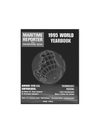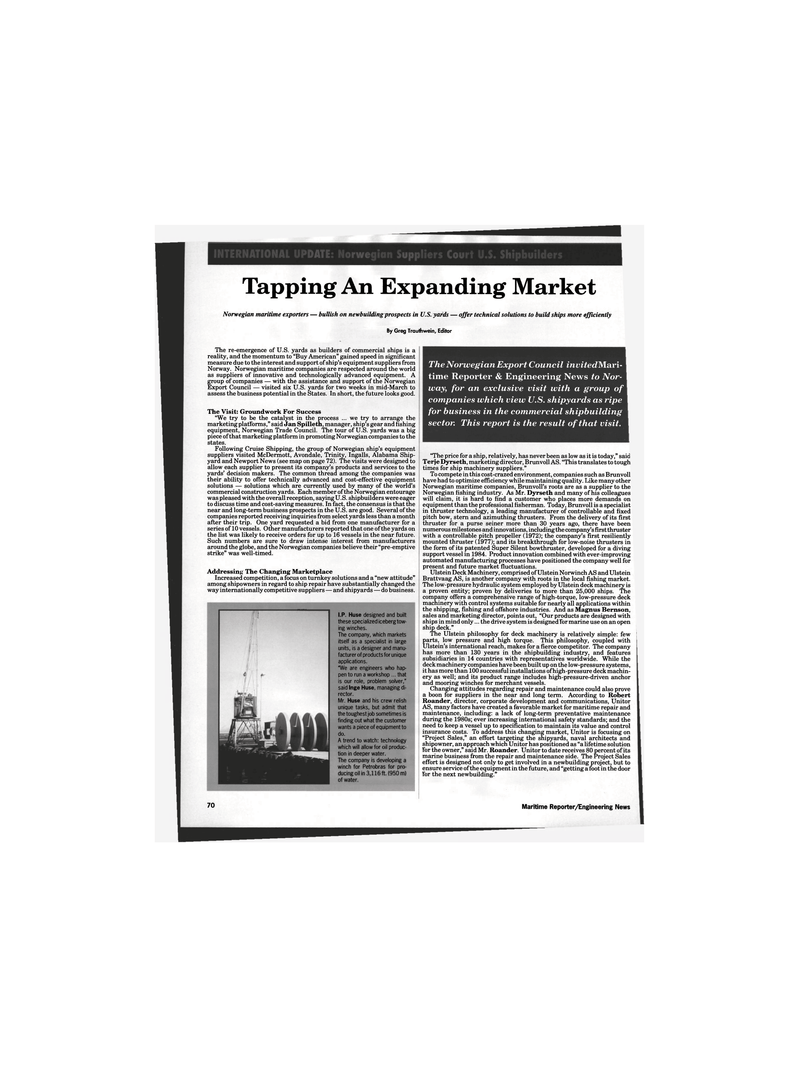
Page 68: of Maritime Reporter Magazine (June 1995)
Read this page in Pdf, Flash or Html5 edition of June 1995 Maritime Reporter Magazine
Tapping An Expanding Market
Norwegian maritime exporters — bullish on newbuilding prospects in U.S. yards — offer technical solutions to build ships more efficiently
By Greg Trauthwein, Editor
The re-emergence of U.S. yards as builders of commercial ships is a reality, and the momentum to "Buy American" gained speed in significant measure due to the interest and support of ship's equipment suppliers from
Norway. Norwegian maritime companies are respected around the world as suppliers of innovative and technologically advanced equipment. A group of companies — with the assistance and support of the Norwegian
Export Council — visited six U.S. yards for two weeks in mid-March to assess the business potential in the States. In short, the future looks good.
The Visit: Groundwork For Success "We try to be the catalyst in the process ... we try to arrange the marketing platforms," said Jan Spilleth, manager, ship's gear and fishing equipment, Norwegian Trade Council. The tour of U.S. yards was a big piece of that marketing platform in promoting Norwegian companies to the states.
Following Cruise Shipping, the group of Norwegian ship's equipment suppliers visited McDermott, Avondale, Trinity, Ingalls, Alabama Ship- yard and Newport News (see map on page 72). The visits were designed to allow each supplier to present its company's products and services to the yards' decision makers. The common thread among the companies was their ability to offer technically advanced and cost-effective equipment solutions — solutions which are currently used by many of the world's commercial construction yards. Each member of the Norwegian entourage was pleased with the overall reception, saying U.S. shipbuilders were eager to discuss time and cost-saving measures. In fact, the consensus is that the near and long-term business prospects in the U.S. are good. Several of the companies reported receiving inquiries from select yards less than a month after their trip. One yard requested a bid from one manufacturer for a series of 10 vessels. Other manufacturers reported that one of the yards on the list was likely to receive orders for up to 16 vessels in the near future.
Such numbers are sure to draw intense interest from manufacturers around the globe, and the Norwegian companies believe their "pre-emptive strike" was well-timed.
Addressing The Changing Marketplace
Increased competition, a focus on turnkey solutions and a "new attitude" among shipowners in regard to ship repair have substantially changed the way internationally competitive suppliers — and shipyards — do business.
I.P. Huse designed and built these specialized iceberg tow- ing winches.
The company, which markets itself as a specialist in large units, is a designer and manu- facturer of products for unique applications. "We are engineers who hap- pen to run a workshop ... that is our role, problem solver," said Inge Huse, managing di- rector.
Mr. Huse and his crew relish unique tasks, but admit that the toughest job sometimes is finding out what the customer wants a piece of equipment to do.
A trend to watch: technology which will allow for oil produc- tion in deeper water.
The company is developing a winch for Petrobras for pro- ducing oil in 3,116ft. (950 m) of water.
The Norwegian Export Council invitedMari- time Reporter & Engineering News to Nor- way, for an exclusive visit with a group of companies which view U.S. shipyards as ripe for business in the commercial shipbuilding sector. This report is the result of that visit. "The price for a ship, relatively, has never been as low as it is today," said
Terje Dyrseth, marketing director, Brunvoll AS. "This translates to tough times for ship machinery suppliers."
To compete in this cost-crazed environment, companies such as Brunvoll have had to optimize efficiency while maintaining quality. Like many other
Norwegian maritime companies, Brunvoll's roots are as a supplier to the
Norwegian fishing industry. As Mr. Dyrseth and many of his colleagues will claim, it is hard to find a customer who places more demands on equipment than the professional fisherman. Today, Brunvoll is a specialist in thruster technology, a leading manufacturer of controllable and fixed pitch bow, stern and azimuthing thrusters. From the delivery of its first thruster for a purse seiner more than 30 years ago, there have been numerous milestones and innovations, including the company's first thruster with a controllable pitch propeller (1972); the company's first resiliency mounted thruster (1977); and its breakthrough for low-noise thrusters in the form of its patented Super Silent bowthruster, developed for a diving support vessel in 1984. Product innovation combined with ever-improving automated manufacturing processes have positioned the company well for present and future market fluctuations.
Ulstein Deck Machinery, comprised of Ulstein Norwinch AS and Ulstein
Brattvaag AS, is another company with roots in the local fishing market.
The low-pressure hydraulic system employed by Ulstein deck machinery is a proven entity; proven by deliveries to more than 25,000 ships. The company offers a comprehensive range of high-torque, low-pressure deck machinery with control systems suitable for nearly all applications within the shipping, fishing and offshore industries. And as Magnus Bernson, sales and marketing director, points out, "Our products are designed with ships in mind only... the drive system is designed for marine use on an open ship deck."
The Ulstein philosophy for deck machinery is relatively simple: few parts, low pressure and high torque. This philosophy, coupled with
Ulstein's international reach, makes for a fierce competitor. The company has more than 130 years in the shipbuilding industry, and features subsidiaries in 14 countries with representatives worldwide. While the deck machinery companies have been built up on the low-pressure systems, it has more than 100 successful installations of high-pressure deck machin- ery as well; and its product range includes high-pressure-driven anchor and mooring winches for merchant vessels.
Changing attitudes regarding repair and maintenance could also prove a boon for suppliers in the near and long term. According to Robert
Roander, director, corporate development and communications, Unitor
AS, many factors have created a favorable market for maritime repair and maintenance, including: a lack of long-term preventative maintenance during the 1980s; ever increasing international safety standards; and the need to keep a vessel up to specification to maintain its value and control insurance costs. To address this changing market, Unitor is focusing on "Project Sales," an effort targeting the shipyards, naval architects and shipowner, an approach which Unitor has positioned as "a lifetime solution for the owner," said Mr. Roander. Unitor to date receives 80 percent of its marine business from the repair and maintenance side. The Project Sales effort is designed not only to get involved in a newbuilding project, but to ensure service of the equipment in the future, and "getting a foot in the door for the next newbuilding." 70 Maritime Reporter/Engineering News

 67
67

 69
69
